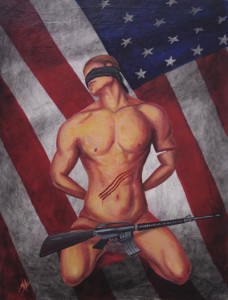Social and political contradictions — a daily reality of life in America — are often tough to acknowledge, and most of us spend our days ignoring or denying the most egregious of them.
Take war. The hard truth is that war kills people, harms the environment, bankrupts nations, destroys international relations, endangers democracy and rarely solves political disagreements. Americans have lived with uninterrupted war for over a decade, yet we are in denial about its consequences. Against all logic, and despite all evidence to the contrary, we consistently elect only presidents who wage or promise to wage more war, and we support politicians who claim that war is necessary for our security. How does one resolve the contradiction between the myths and realities of war?
If you’re an “average” American, you simply ignore the problem and go shopping. If you’re an artist like Shelly Leitheiser, you put brush to canvas and protest.
“I like art that has some meaning, that tells a story,” says Leitheiser. The stories she tells might be considered “truth tales.” Leitheiser exposes the contradictions in political doublespeak by juxtaposing incongruous images that shock the viewer into seeing beyond conventional norms. In her paintings, fantasy and reality confront one another, creating momentary confusion, but ultimately opening the door to an alternate way of seeing, to clarity and revelation.
Leitheiser’s compelling imagery and use of juxtapositions hark back to the highly politicized Dada and Surrealist movements. In his 1924 Manifesto of Surrealism, André Breton cited the words of the poet Pierre Reverdy:
“The image is a pure creation of the mind. It cannot be born from a comparison but from a juxtaposition of two more or less distant realities. The more the relationship between the two juxtaposed realities is distant and true, the stronger the image will be—the greater its emotional power and poetic reality….” (Nord-Sud, March 1918)
In Leitheiser’s work, surrealist juxtaposition complements the social realist notion of art as a weapon. The results are impressive. Her images force us to critically question our preconceived, deeply embedded ideas about patriotism, war and technology.
In “The Volunteer,” we see the seduction of war, the folly of blind patriotism, the machismo culture of the military, the glorification of violence—and the broken bodies and minds that are war’s ultimate reality. War makes victims, but, Leitheiser believes, soldiers who fight wars are also victims of war. Like the blindfolded volunteer in her painting, the soldier too is a victim of political duplicity. The theme of the cultural conditioning of society for war runs through several of her paintings.
“Love the Drone” juxtaposes one of the military’s highest technological achievements with an adoring woman in a negligee. “Weapons are sexy to a lot of Americans,” says Leitheiser, “and they see drones as really cool militaristic technology.” The public becomes comfortable with this technology of death because of the way it’s packaged for public consumption. Some of the video games kids play are actually designed by the Pentagon, notes Leitheiser, and drones, controlled remotely by technicians thousands of miles away, are very much like a video game. How better to condition the young to uncritically accept war and deny its consequences than by transforming it into fantasy!
“Collateral Damage” highlights Leitheiser’s interest in connecting war to environmental destruction and climate change. The painting is a peaceful scene of children playing in unspoiled nature. The contradiction between the image and its title jars us into seeing how cheap life is in a militaristic culture, and how war threatens our families, our future and our earth.
Perhaps “Complacency” is the harshest indictment of American society. A middle-class woman sits comfortably on her sofa, ignoring the peace dove and blood on her carpet, while a chaotic scene of bombs exploding and refugees fleeing rages just outside her window.
Leitheiser is dealing with dangerous stuff. When was the last time you saw politically provocative art in a gallery or exhibition? Yet, protest art has a strong tradition in American culture. In the 1930s, artists like Ben Shahn and Philip Evergood boldly tackled the dangers of fascism and the injustices of the rich toward ordinary Americans. They were accused of being propagandists, but Leitheiser rejects that epitaph for her art. She believes that, “Propaganda comes from governments or corporations, not from individual artists. Individuals use their own ideas. Whatever comes out of the artist’s mind is something they’re emotionally connected to—it can’t be propaganda when it comes from their heart.”
Leitheiser’s next project will be a series of portraits of Afghan children because she wants to emphasize the individuality of war victims. As she explains, “They are real people—they’re not abstractions—they’re little kids who want a future. I just want people to see the humanity in their faces.”
And what about her antiwar art? You won’t find it in a bricks-and-mortar gallery, but Leitheiser has organized a group called Antiwar Artists, and their work is available on their website. They’re planning an online exhibit in August and are calling for artists to contribute images of their work.
Visit the website:
http://www.antiwarartists.com/
Visit the Antiwar Artists’ gallery:
http://www.antiwarartists.com/gallery/
Current and Upcoming exhibits:
● Leitheiser is currently part of “Our Earth,” a group show running through May 5th at Flow Art Space, in the Keg House building in NE Minneapolis.
● From April 30 to June 8, Leitheiser will exhibit her environmental art in “Kinetic Connections,” a two-person show with Deborah Vander Eyk at the Minnesota Women’s Building. The opening reception is Saturday, May 5th, from 6 to 9 pm, free and open to the public.
● On May 1st, Leitheiser will have a 9-piece solo show at the Whitney Center in St. Cloud.
● And, of course, Leitheiser will participate in Art-A-Whirl 2012. She’ll be exhibiting recent art at the Fitness Crossroad location, 2912 Pentagon Drive, St. Anthony Shopping Center, Minneapolis.
For more information about Shelly Leitheiser, visit her website:
http://leitworks.com/tag/shelly-leitheiser/


